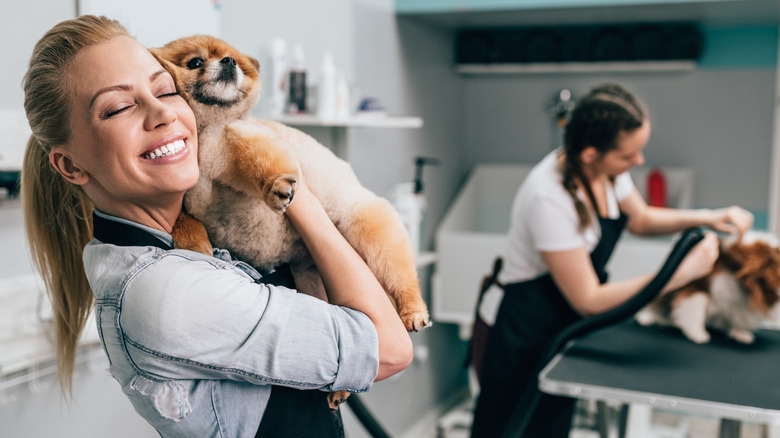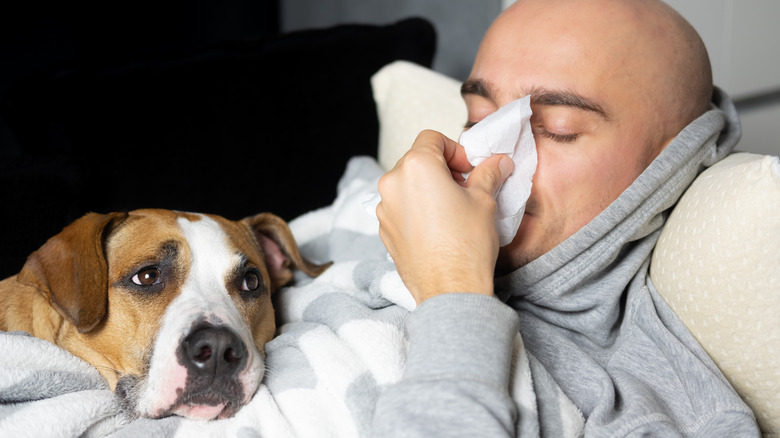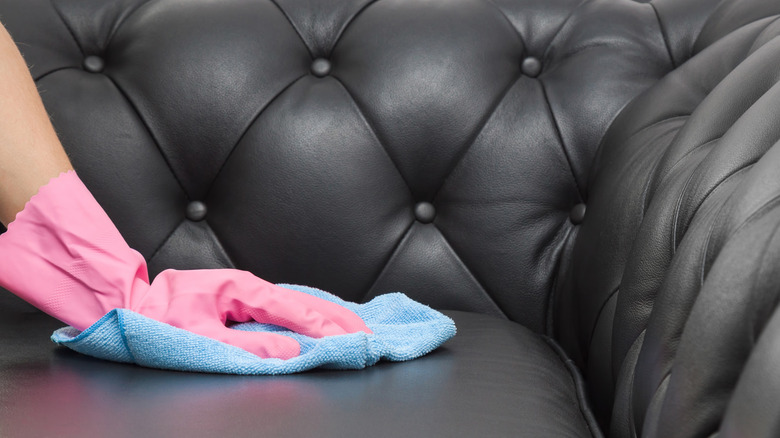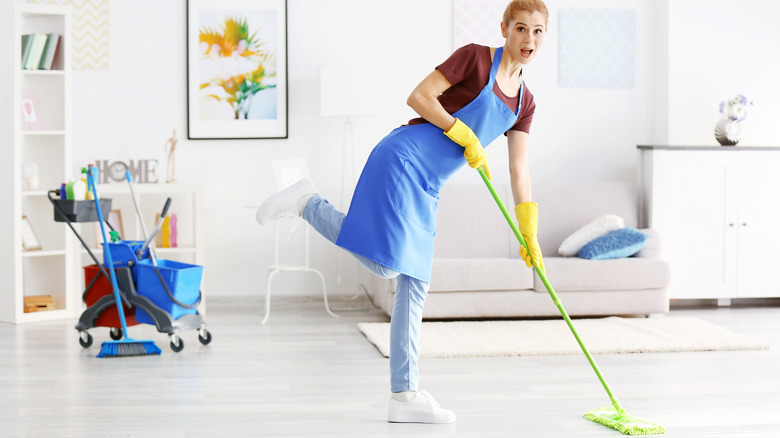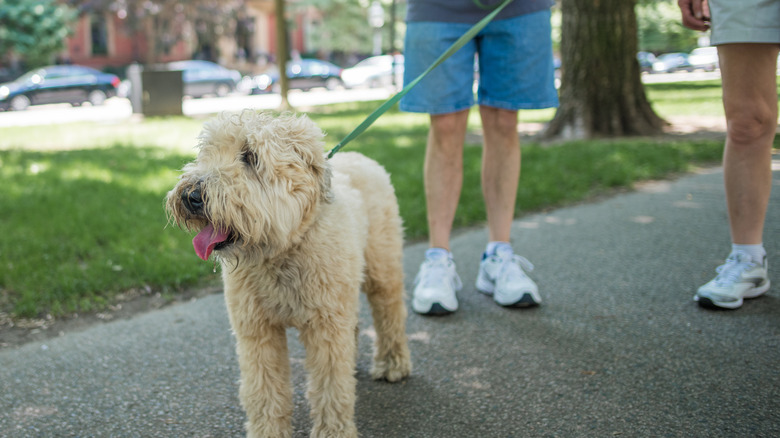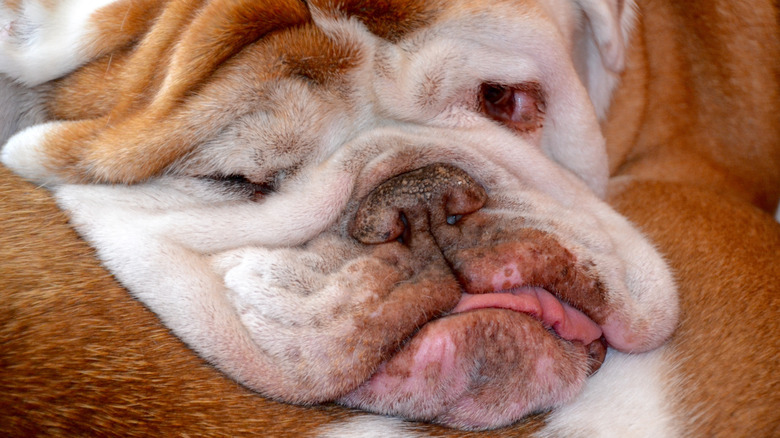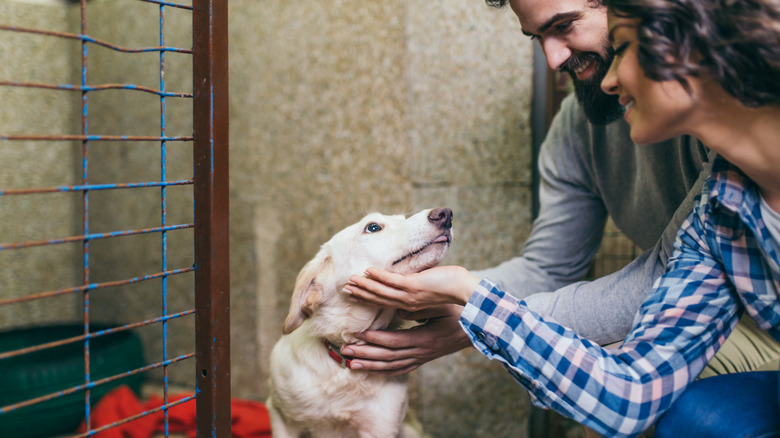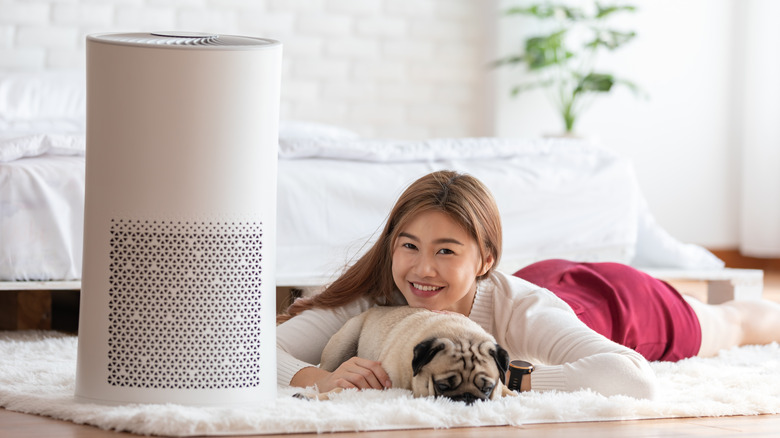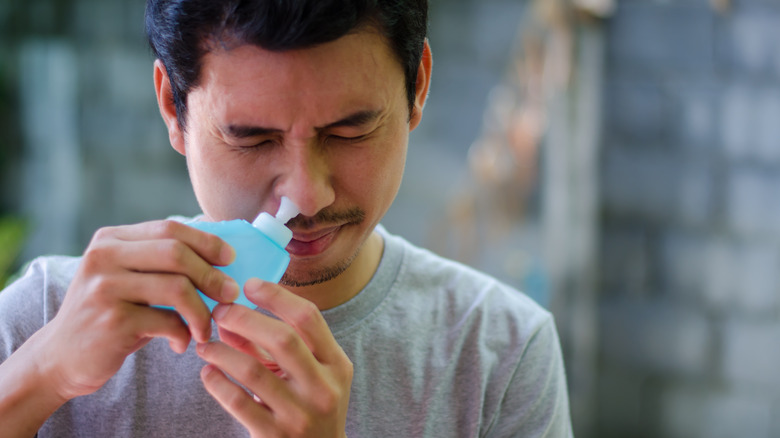How To Live With A Dog If You're Allergic To It
The United States is a dog-loving country, with about 63.4 million households having one or more canine companions (via FinancesOnine). Sadly, allergies to dogs and other pets also affect millions of U.S. folks, says The Ohio State University College of Veterinary Medicine. So if you're miserable with sniffing, sneezing, itchy eyes, and even hives, it makes sense you'll come to the crushing conclusion that the dog must go.
But it's not that simple, is it? Chances are the dog is a beloved family member that has wormed its way into everybody's heart, and the idea of parting with it is inconceivable.
So what can you do? Actually, quite a lot, including getting to the bottom of what exactly is kicking off your allergies and taking systematic steps to minimize those allergens in your home. With some effort, consistency, and willingness to try some options that may seem unlikely at first, there's a good chance you can keep your allergy symptoms under control and live in harmony with your canine companion.
Make sure it's the dog you're allergic to
A good first step is to schedule a doctor's appointment and get an allergy test. There are several types of tests, with one involving a simple skin prick that deposits a tiny amount of allergens under your skin, and another called an intradermal skin test where allergens are injected deeper into your skin (via Allergy & Asthma Specialists).
Rather than being allergic to your dog, tests may show that you're allergic to dust mites, mold, pollen, or a variety of other allergens, says the Mayo Clinic. You may even find that you're allergic to an allergen outside your home that comes in on your dog's fur and can be easily wiped away, per The Humane Society of the United States.
If, in fact, you're allergic to your dog, you might assume that its fur is what's causing the problem. That may be true, indirectly. Dogs have allergy-causing proteins in their skin glands, and when dry skin — complete with allergens — flakes off, presto: allergens get in the dog's fur, where they drop or are shaken all over your clothes, bedding, carpets, furnishings, and walls. Allergens also come from a dog's saliva and urine.
Everyone reacts to allergens differently, and your symptoms may be minor or life-threatening. If you're also allergic to cigarette smoke, dust mites, pollen, or mold, your symptoms may be intensified.
Groom your dog frequently to minimize allergens
Keeping your dog clean and brushed is an essential next step in minimizing the allergens that are flying off your pet and into your home (via Primped Pooches).
Whether you take your dog to a groomer or go for the DIY approach, be sure that the shampoos used to bathe your dog are all-natural and unscented so you don't introduce any additional allergens into an already complicated situation.
Brushing your dog at least weekly will help clear out dead skin and hair that may otherwise end up all over your house, says Hills Pet Nutrition, and you may need to up the brushing schedule in the months when your dog is doing a lot of shedding. If possible, brushing should be done by someone who isn't allergic to your dog, and it's best if it's done outside, for obvious reasons.
Remember that secretions from your dog's eyes and ears can also contain allergens, so keep those cleaned out as well, adds Primped Pooches.
Keep your dog off your bed
If one of your joys is sleeping with your dog, it may be almost inconceivable to deprive yourself and your pet of that daily pleasure. But think this through: you spend significant portions of every day in your bed, and your pillows, sheets, and blankets are right up close to your nose and eyes, where allergens can trigger symptoms like a stuffy nose, itchy eyes, and sneezing, says Dr. Philip A. Matorin.
Besides, let's admit it, dogs don't necessarily make ideal bed partners for other reasons as well. They tend to shift around during the night, taking over more and more of your bed, snoring, kicking, and generally contributing to a less-than-ideal rest (via the sleep company Casper).
If all this sounds painfully familiar, consider weaning your dog from sleeping on your bed and relocating it to its own dog bed in your bedroom. Choose the bed carefully based on your dog's size, age, and sleeping habits, says WebMD. If it likes to curl up and snuggle, a donut bed might be just the thing. If your dog is a senior with plenty of aches and pains, it might think it's pure luxury to have an orthopedic bed made from memory foam. And flat mattress pad beds are popular among dogs that like to spread out and change positions while they sleep.
Make your bedroom a pet-free zone
If keeping your dog off your bed is a challenging concept, keeping it out of your bedroom entirely — especially if it's already been allowed there — will take some training for the dog, and consistency and willpower on your part. But your bedroom is the best choice for an allergy-free zone since you spend so much time there.
Using a baby gate to block the dog from the room is a good first step. It allows the dog to see and hear you at least, rather than being isolated behind a closed door, and to enforce the boundary when you're not able to supervise your pet, says Wag!.
Next comes a lot of training. Leash your dog and walk past your bedroom. Keep walking, even if your dog wants to veer into the room. Lavish it with praise and a favorite treat once you're beyond the doorway, then repeat, repeat, repeat until your dog is getting the hang of avoiding the room. A heads up here: this could take some time.
Eventually, you may be able to remove the baby gate and replace it with a strip of painter's tape on the floor or some other minimalist "no entry" signal to your pet. If you catch the dog entering the room anyway, redirect it to a dog bed or favorite toy in another room. You need to catch your dog in the act of entering if you're going to reprimand it.
Minimize the fabric furnishings in your home
Allergens cling to carpeting, draperies, and fabric furnishings, so if you can minimize those in your home you're going to make a lot of headway toward managing your allergies, says the Asthma and Allergy Foundation of America.
If possible, remove carpeting and replace it with hard-surface flooring that can be easily cleaned. As an added precaution, look for flooring products that are certified to be asthma- and allergy-friendly. Rather than fabric draperies, consider blinds that can be frequently dusted, and choose non-fabric couches and chairs that can be easily cleaned off. While fabric furniture may be your favorite, consider all the nooks and crannies where allergens can hide (via MasterClass). Leather repels allergens rather than collecting them, as well as resisting stains.
Of course, totally overhauling your home for the love of your dog may not be a practical solution. In that case, use throw rugs over carpets and slipcovers, sheets, or blankets on furniture so you can wash them frequently.
Keep your home super clean
Allergens from your dog can cling to every surface, including walls and ceilings, and cleaning your house thoroughly and often will help keep your allergic symptoms at bay.
If you're lucky enough to have hard-surface floors, mop them or use a damp cloth to wipe them down, says the Cleveland Clinic. If you have carpets, use a vacuum cleaner with a HEPA filter. The filter helps collect allergens in the vacuum rather than releasing them back into the room.
Also, vacuum your draperies and fabric furniture, says HomeAdvisor, and dust flat surfaces such as tables, bookshelves, nightstands, walls, and lampshades where allergens can collect, using a static duster or damp cloth so you don't just spread the allergens around. Remember that you're going to be stirring up a lot of stuff while you're cleaning, so wear a mask to avoid inhaling it all and making your allergy symptoms even worse.
If all this cleaning sounds overwhelming, divide the tasks into days of the week and do one or two every day. On days you can't clean, consider using a pet dander allergy spray, which can deactivate pet dander — but make sure it's a pet-friendly variety. And, if you can afford it, splurge on a professional housecleaning service so you can just relax and spend more time enjoying your pup.
Take the hypoallergenic dog breeds theory with a grain of salt
Allergic to dogs but love them anyway? All you need to do is choose a hypoallergenic breed, right? Unfortunately, that's somewhat of a myth. While you may have better luck with some breeds than others, there's no guarantee that even a hairless dog won't bring on the dreaded itchy eyes and congestion. That's because proteins that cause symptoms can come from the saliva, skin, and urine of your pet, according to the American Kennel Club (AKC). Even letting a dog, any dog, lick your face can trigger your symptoms.
That being said, it's not just poodles that are a decent bet for people with pet allergies. The AKC offers up a surprisingly long list of dog breeds that may be good choices for allergy sufferers, ranging from Afghan Hounds to Soft-coated Wheaten Terriers and Irish Water Spaniels.
Smaller dogs have less of everything to contend with, including allergens, but be sure to consider everything about the dog breed if you're selecting a new dog for your household. Are you best suited to a high-energy dog or a cuddly couch potato? A big or little dog? A dog that needs a lot of grooming, or not so much? Everything about a dog is important when you're choosing a new family member.
Certain dog breeds are especially poor choices if you're allergic
While best dog breeds for allergy sufferers may be a questionable concept, worst breeds seem a little more clearcut, says The Spruce Pets.
Let's start with dogs that drool excessively, leaving their saliva all over everything. Saint Bernards come immediately to mind, along with Bassett Hounds, Bloodhounds, Bernese Mountain Dogs, Newfoundlands, Mastiffs, and Bulldogs. See spectacularly droopy jowls, and it's a pretty safe bet the dog is a champion drooler.
The type of coat the dog has can also tip you off as to its allergen potential. While you might think that a Doberman Pinscher, for example, would be a good choice because of its thin coat, these dogs commonly have skin allergies that can cause flaking skin and trigger your allergies. And because they're big dogs, you'll have plenty of dry, flaky skin to deal with in your home.
Then there are the dogs with thick, double coats, like Siberian Huskies and German Shepherds, both very popular dogs. The problem here is that they tend to be massive shedders, leaving fur all over your house.
And what about dogs that are especially hard to house train? The Pekingese is one breed that gets a prize there, because it tends to be stubborn about house training and favors marking all over your house with its urine – a common allergy trigger. Other breeds that are hard to house train include Chihauhuas, Bichon Frises, Beagles, and American Foxhounds (via Newsweek).
Do thorough homework before selecting a dog
While you may already have an idea of what breed or mix of breeds you'd like, remember that you really can't generalize when it comes to individual dogs, people, and allergens (via VCA Animal Hospitals).
Let's say you'd love to have a darling little Maltese. Start by visiting some, petting them, and spending time with them, while noticing whether your allergies flare up, says the AKC. If all goes well, consider pet sitting someone's Maltese for a day or two to give your allergies a concentrated test.
While those are both good experiments, only by interacting with the specific dog you want to adopt will you be sure to get an accurate reading on any allergic reactions you may have. And if your allergies act up but you fall in love with the dog anyway, it's time to decide whether you're willing to take allergen-reducing steps to minimize your symptoms.
Before automatically heading to a breeder for your new dog, remember that there are hundreds of thousands of dogs in shelters that quite likely will face euthanasia if they don't find new homes — and quickly. Visiting dogs at shelters or foster homes, or fostering a dog yourself with the option to adopt, are other ways to get to know a dog and determine if you and your allergies can happily and healthfully coexist with it.
Use an air purifier to capture pet allergens
Air purifiers filter allergens and a variety of other particles out of the air and can greatly improve allergic symptoms brought on by your pooch (via Molekule). Specifically, air purifiers with HEPA filters are said to remove 99.97% of large particles, including — believe it or not — sucking up pet hair that's floating around in the air.
For all their benefits, HEPA filters aren't so great at collecting smaller particles, including pet dander and saliva, and may even expel them back into the air. For best results, choose an air purifier that's designed to deal with both large and small particles, and remember to change the filter frequently, since you and your pet are assigning a gargantuan cleaning task to the device.
You might wonder if the air filter on your home's HVAC system is adequate for pulling pet allergens out of your home's air, and the answer is no, according to Aire Serv. That filter only captures large particles and is designed to keep the HVAC system in good working order, not to ensure you have ultra clean air in your home. You'll still want to have a good quality filter on the system that you replace regularly, but a separate air purifier that's designed specifically to clean your home's air is also recommended.
Try non-drug solutions to control your allergy symptoms
If all these allergy-fighting remedies still don't kick your symptoms or minimize them enough to let you comfortably live with your fur baby, consider the allergy treatment options.
Non-drug approaches include moistening and irrigating your nasal passages with saline nasal sprays or nasal irrigation devices such as a squeeze bottle, neti pot, or bulb syringe (via the U.S. Food & Drug Administration). Liquids you can use include saltwater or a saline solution. Don't use tap water because it isn't treated or filtered enough to remove organisms that can actually take up residence in your nasal passages and add to your problems. Instead, use sterile, distilled, or boiled and cooled water.
Allergen immunotherapy is another non-drug approach that can have long-lasting results, says Allergy & Asthma Specialists. Once you determine that you're actually allergic to your dog, your doctor may recommend injecting small amounts of those allergens into your body and gradually increasing the amounts as you build up your immunity. This technique is called subcutaneous immunotherapy (SCIT) and it can treat multiple allergies at the same time.
Other non-drug treatments that some people find effective include acupuncture and essential oil diffusers.
If all else fails, medication may be the answer
Over-the-counter and prescription allergy medications curb symptoms for many people. Antihistamines block the effects of allergens and are available in brand names that include Zyrtec, Allegra, Claritin, and Benadryl (via WebMD). Decongestants like Allegra-D and Sudafed relieve nasal congestion, and nasal steroids like Flonase go to work on nasal inflammation. Allergy shots work for some people, but not everyone. Still, other options include eye drops to ease itching and redness, and inhalers to treat asthma brought on by allergens.
Even if medication works wonders for you, there are some significant side effects that may curb your enthusiasm. Antihistamine use can lead to headaches, dry mouth and eyes, drowsiness, dizziness, and rapid heart beat, says the Cleveland Clinic. Some people experience increased anxiety or depression, constipation, and weight gain, and there's even evidence that long-term use of some antihistamines can increase your chances of getting dementia.
Medications for diabetes, heart disease, hypertension, epilepsy, Parkinson's disease, and other chronic conditions may be rendered ineffective when combined with oral decongestants, says the Mayo Clinic, and that's just the beginning of the bad news. Add insomnia, tremors, and nervousness to the list of possible side effects, and skip the caffeine and herbal supplements because they can increase your chances of experiencing side effects.
One last caution is to only use a nonprescription decongestant spray for three or four days. Any longer and you might experience rebound rhinitis and even worse congestion.



